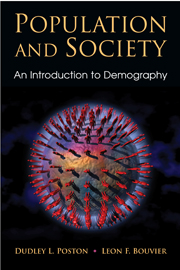Book contents
- Frontmatter
- Contents
- Preface
- Introduction
- 1 “We Are All Population Actors”: An Introduction to Demography
- 2 The Sources of Demographic Information
- 3 Fertility
- 4 Contraception and Birth Control
- 5 Mortality
- 6 Internal Migration
- 7 International Migration
- 8 Age and Sex Composition
- 9 World Population Change over Time
- 10 Population Change in the United States
- 11 Population Distribution
- 12 Cultural Adaptation and Growth
- 13 Population Policy
- 14 The Future of Planet Earth
- Glossary
- References
- Author Index
- Subject Index
9 - World Population Change over Time
- Frontmatter
- Contents
- Preface
- Introduction
- 1 “We Are All Population Actors”: An Introduction to Demography
- 2 The Sources of Demographic Information
- 3 Fertility
- 4 Contraception and Birth Control
- 5 Mortality
- 6 Internal Migration
- 7 International Migration
- 8 Age and Sex Composition
- 9 World Population Change over Time
- 10 Population Change in the United States
- 11 Population Distribution
- 12 Cultural Adaptation and Growth
- 13 Population Policy
- 14 The Future of Planet Earth
- Glossary
- References
- Author Index
- Subject Index
Summary
INTRODUCTION
Having finished discussion of the three demographic processes in the preceding chapters, we are now in a position to put them all together and analyze overall population change. This chapter deals with the dynamics of world population change over time, and the next chapter (Chapter 10) with U.S. population change.
To help better understand the issues presented in the chapter, we first examine the different ways that writers over the centuries have written about population and population change, and some of the main theories of population change, particularly demographic transition theory (DTT). We then look specifically at the dynamics of world population change, taking both a long and a short view. We conclude the chapter with a discussion of the future of world population.
How large is the population of the world, and how rapidly is it growing? The U.S. Bureau of the Census estimates that the world population numbered more than 6.6 billion people in 2007. The crude birth rate (CBR) was around 21/1,000, and the crude death rate (CDR) about 9/1,000. Thus, the rate of annual growth was about 1.2 percent. So, if these birth and death rates were to continue into the future, the population numbers would double about every 58 years (see our discussion of doubling time later in this chapter). Of course, such astronomical numbers are unlikely to occur. Either the birth rate will fall or the death rate will rise.
- Type
- Chapter
- Information
- Population and SocietyAn Introduction to Demography, pp. 265 - 285Publisher: Cambridge University PressPrint publication year: 2010



